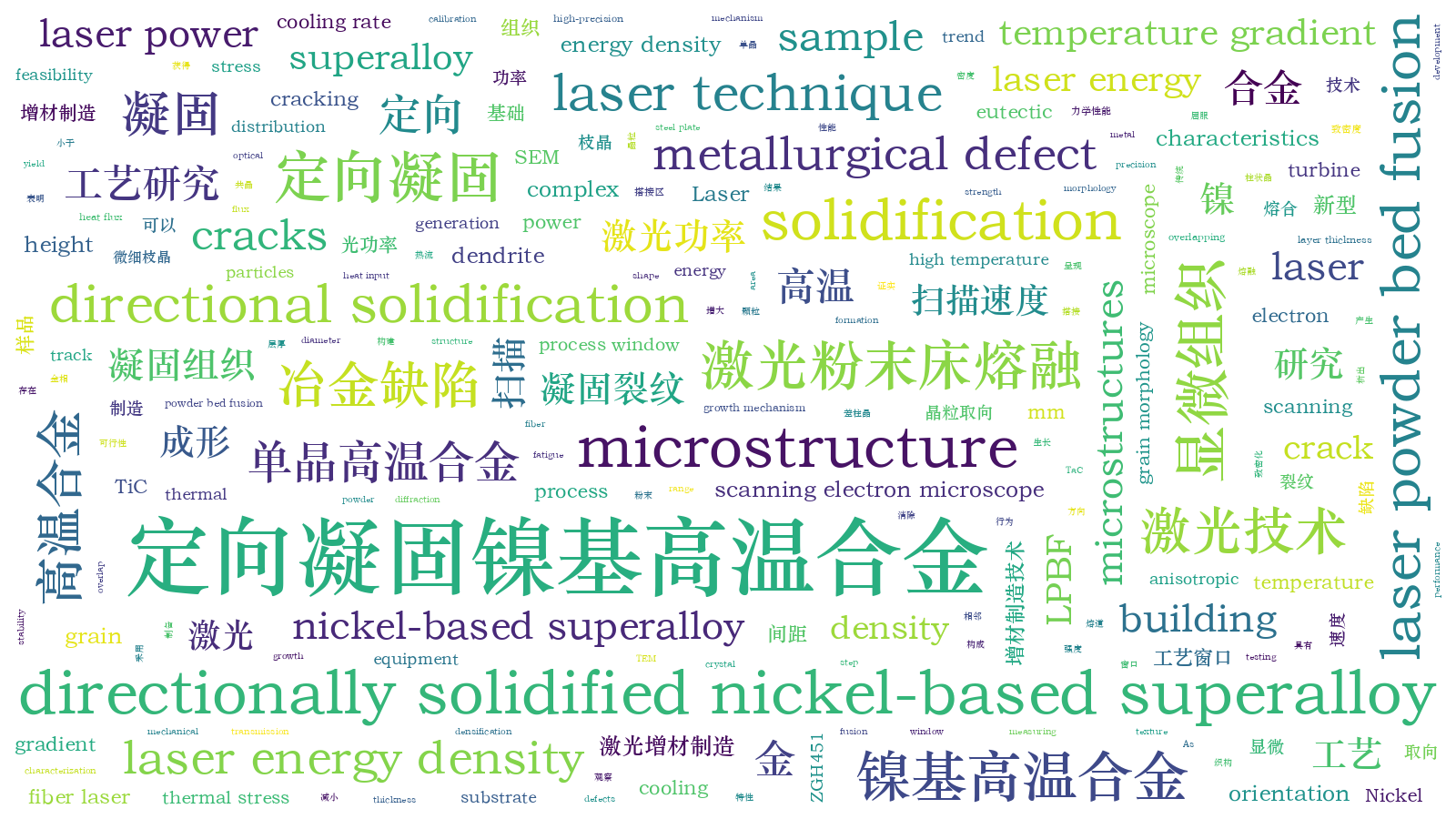LPBF成形新型定向凝固镍基高温合金基础工艺研究
The traditional directional solidification process has made outstanding contributions to improving the thermal-mechanical fatigue performance and service cycle of turbine blades. However, the traditional directional solidification process has limitations. It not only hampers the formation of new generation of turbine blades with complex cooling structures, but also results in a coarse microstructure and microporosity, along with γ/γ' eutectic. These issues restrict further development of directional solidification turbine blades. Laser powder bed fusion (LPBF) technology can form almost any complex shape of metal components. Meanwhile, LPBF technology has an extremely high cooling rate (103?106 K/s) and temperature gradient (103?105 K/s), which is expected to eliminate the above-mentioned defects and form a finer microstructure. In this study, the densification behavior, microstructure, and solidification grain orientation of a new directionally solidified nickel-based superalloy, ZGH451, fabricated using LPBF are investigated. The feasibility of using LPBF technology to form a directionally solidified nickel-based superalloy, ZGH451, is confirmed.
A self-developed LPBF equipment is used for ZGH451 experiments. The equipment includes a fiber laser with a spot diameter of approximately 80 μm. Cubes measuring 10 mm×10 mm×5 mm are produced on 45# cast steel plates. Optical micrographs (OM) are collected using a optical microscope. The microstructures of the samples are observed using a scanning electron microscope (SEM). An SEM with electron backscattered diffraction (EBSD) is used to characterize the grain morphology and orientation characteristics. The EBSD scanning step is performed at 1.5 μm. The final calibration rates are all greater than 95%. The inter-dendritic precipitates of the samples are analyzed using a transmission electron microscope (TEM). The tensile specimens are tested on a high-precision electronic universal testing machine at a constant drawing rate of 2 mm/min.
This study successfully forms a crack-free, high-density (99.9%) ZGH451 sample. The primary dendrite spacing is less than 1 μm, and the secondary dendrite is underdeveloped. There are TiC and TaC particles precipitated between dendrites, and there is no obvious γ/γ' eutectic. The typical microscopic characteristics of cracks are observed by SEM, as shown in Figs. 6(a) and (b). The cracks mainly originate at the bottom of the molten track and grow along the building direction. The EBSD results indicate that the cracks [Fig.6(c)] exhibit evident intergranular cracking characteristics. Therefore, the cracks are determined to be solidification cracks. The occurrence of solidification cracks in the ZGH451 alloy formed via LPBF is closely related to its thermal stress state and microstructural characteristics during solidification. In this study, when the laser power is reduced from 200 W to 150 W, a crack-free sample is obtained at an appropriate laser energy density. A lower laser power or laser energy density leads to a faster cooling rate and finer microstructure, making it easier to adapt to the solidification stress at the end of solidification in the molten track. In addition, compared with the traditional directionally solidified superalloy, the ZGH451 alloy increases the proportion of the Hf element. Hf transforms the MC carbides from a continuous distribution to a dispersed distribution, improving the stability of the grain boundaries and carbides and suppressing cracking. In addition, researchers have found that the directional solidification trend of directionally solidified nickel-based superalloys formed by LPBF tends to weaken with increasing building height. Therefore, a crack-free ZGH451 sample (building height of 5 mm) is selected for characterization by EBSD at the bottom, middle, and top positions. As shown in Fig. 9, within the building height range used in this study, the directional solidification trend of the ZGH451 alloy is not weakened, and the directional solidification trends of the middle and top of the sample are more evident than that of the bottom of the sample. This phenomenon relates not only to the strong directional solidification tendency of the new directionally solidified alloy but also to the substrate used. Specifically, the extremely high heat input of the LPBF produces an extremely high temperature gradient from the top to the bottom along the building direction. However, because the substrate used in this study is a stainless-steel plate, the grain orientation at the bottom of the sample is relatively disordered. Under the competitive growth mechanism, as the building height continues to increase, the front edges of the grains deviating from the temperature gradient gradually lag behind those of the preferentially oriented grains and are eliminated. Due to the extremely fine microstructure of the sample, its yield strength [(979.5±31.0)MPa] is equivalent to that of the third-generation single-crystal nickel-based superalloy (1017 MPa). However, anisotropic grains are still generated by the lateral heat flux caused by the overlap of the molten tracks.
Within the process window of 150 W laser power, 0.02 mm layer thickness, 600?800 mm/s scanning velocity, and 0.06?0.08 mm hatch spacing, crack-free and high-density (99.9%) samples can be obtained. The solidified structure is primarily composed of columnar grains that grow along the build direction. The primary dendrite spacing is less than 1 μm, and the secondary dendrite is underdeveloped. There are TiC and TaC particles precipitated between dendrites, and there is no obvious γ/γ' eutectic. The as-built ZGH451 exhibits a texture along [001], but anisotropic grains remain owing to the complex heat flow in the overlapping area between adjacent molten tracks. The feasibility of using LPBF technology to form a directionally solidified nickel-based superalloy, ZGH451, has been confirmed; however, the problem of inconsistent orientation caused by complex heat flows still needs to be solved.
周润森, 魏恺文, 梁静静, 陈佳, 李高航, 屈亮, 刘梦娜, 李祥友, 孙晓峰, 曾晓雁. LPBF成形新型定向凝固镍基高温合金基础工艺研究[J]. 中国激光, 2023, 50(24): 2402304. Runsen Zhou, Kaiwen Wei, Jingjing Liang, Jia Chen, Gaohang Li, Liang Qu, Mengna Liu, Xiangyou Li, Xiaofeng Sun, Xiaoyan Zeng. Basic Process of New Directional Solidification Nickel‑Based Superalloy Fabricated by Laser Powder Bed Fusion[J]. Chinese Journal of Lasers, 2023, 50(24): 2402304.







